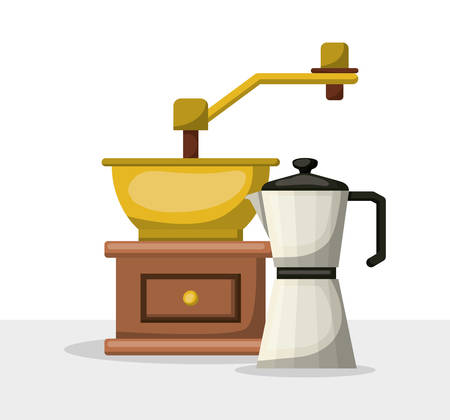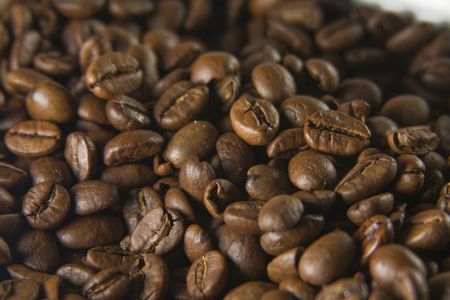1. The Real MVP of Your Morning Brew
When it comes to making a great cup of coffee at home, most people immediately think about the coffee maker. But heres the thing—your grinder actually plays a bigger role than you might think. In fact, its often the real MVP (Most Valuable Player) of your morning routine.
The grinder is where everything starts. It determines how evenly your coffee beans are ground, which directly affects flavor, strength, and consistency. A high-quality grinder can unlock complex flavors hidden in your beans, while a poor grinder can leave you with a bitter or weak cup—no matter how expensive your coffee maker is.
Why the Grinder Matters More Than You Think
Brewing great coffee is all about precision and consistency. Your grinder controls both by determining grind size and uniformity. Whether youre brewing with a French press, drip machine, pour-over, or espresso machine, the grind size needs to match the method for optimal extraction.
Grind Size Comparison by Brew Method
| Brew Method | Recommended Grind Size | Importance of Consistency |
|---|---|---|
| French Press | Coarse | Prevents over-extraction and bitterness |
| Drip Coffee Maker | Medium | Keeps flavor balanced and smooth |
| Pour-Over | Medium-Fine | Controls flow rate and flavor clarity |
| Espresso Machine | Fine | Essential for proper pressure and crema |
Burr vs. Blade Grinders: Not All Grinders Are Created Equal
If youve been using a blade grinder (the kind that looks like a mini blender), its time to upgrade. Blade grinders chop beans unevenly, leading to inconsistent extraction. Burr grinders, on the other hand, crush beans between two surfaces for a uniform grind every time.
Burr Grinder Benefits:
- Consistent grind size for better flavor control
- Adjustable settings for different brew methods
- Less heat during grinding, preserving bean quality
The takeaway? If youre serious about your coffee game, investing in a good grinder is more impactful than splurging on a fancy coffee maker. Start with the foundation—the grind—and youll taste the difference in every sip.
2. Freshness Starts with the Grind
When it comes to brewing a great cup of coffee, timing is everything—especially when it comes to grinding your beans. You might not realize it, but the moment coffee beans are ground, they start to lose their flavor and aroma. That’s why grinding your beans right before you brew can make all the difference in taste and quality.
Why Freshly Ground Coffee Tastes Better
Coffee beans are packed with oils and compounds that give your coffee its distinct flavor and aroma. Once ground, those compounds start reacting with oxygen—a process called oxidation. Oxidation quickly dulls the vibrant notes of your coffee, leading to a stale or flat taste.
The Science Behind It
Grinding increases the surface area of the beans, which speeds up oxidation. Heres a quick breakdown:
| Stage | What Happens | Impact on Flavor |
|---|---|---|
| Whole Bean | Minimal exposure to air | Flavor stays locked in |
| Freshly Ground | Max flavor extraction when brewed immediately | Full aroma and taste |
| Pre-ground (stored) | Long-term air exposure | Dull, less flavorful cup |
Aroma Matters More Than You Think
Your sense of smell plays a big role in how you experience coffee. Freshly ground beans release gases like carbon dioxide that carry aromatic oils into the air—the stuff that makes your kitchen smell amazing when brewing. Pre-ground coffee loses these aromas fast, leaving you with a less immersive experience.
No Fancy Gear Needed—Just the Right Grinder
You don’t need a $1,000 espresso machine to enjoy great coffee at home—but having a good grinder is non-negotiable. A burr grinder, for example, gives you control over grind size and consistency, which directly affects how evenly your coffee extracts during brewing.
Quick Tip:
If youre using a drip machine or pour-over setup, aim for a medium grind; for French press, go coarse; for espresso, go fine. Matching grind size to your brewing method ensures youre getting the most out of those fresh grounds.
The bottom line? If you want better-tasting coffee every day, investing in a good grinder—and using it just before brewing—is one of the smartest moves you can make.

3. How Grind Consistency Affects Flavor
When it comes to brewing a great cup of coffee, grind consistency plays a much bigger role than most people realize. While your coffee maker controls water temperature and brew time, its your grinder that determines how evenly your coffee extracts. And trust us—this makes all the difference between a delicious cup and one thats just… meh.
Why Inconsistent Grinds Are a Problem
If your coffee grounds are uneven—some fine like powder and others coarse like sea salt—you’re going to end up with both over-extracted and under-extracted flavors in the same cup. Over-extracted grounds taste bitter and harsh, while under-extracted ones taste sour and weak. The result? A confusing mix of flavors that don’t really work together.
How Extraction Works
Extraction is simply how much flavor is pulled from the coffee grounds by hot water. Different grind sizes extract at different rates:
| Grind Size | Extraction Result | Taste |
|---|---|---|
| Too Fine | Over-extracted | Bitter, dry, harsh |
| Too Coarse | Under-extracted | Sour, weak, flat |
| Consistent & Even | Balanced extraction | Rich, smooth, flavorful |
The Grinder’s Role in Flavor Balance
A high-quality grinder produces uniform grounds that extract evenly, giving you a cup that’s well-balanced and full of flavor. This is especially important if youre using manual brew methods like pour-over or French press, where you control more variables in the brewing process. Even automatic drip machines benefit hugely from consistent grinds.
Pro Tip:
Burr grinders are generally better than blade grinders when it comes to consistency. Blade grinders chop unevenly, while burr grinders crush beans uniformly for better control over flavor.
The Bottom Line on Grind Consistency
No matter how expensive your coffee maker is, it can’t fix uneven grinds. Investing in a quality grinder ensures that every cup you brew has the potential to be rich, balanced, and satisfying—just the way good coffee should be.
4. Blade vs. Burr: The Great Debate
If youre just starting your coffee journey, you might think a grinder is just a grinder. But when it comes to getting that perfect cup, the type of grinder you use can make or break your brew. In the world of coffee grinding, there are two main types: blade grinders and burr grinders. Let’s break down the key differences and why burr grinders are the go-to for most coffee lovers in America.
Blade Grinders: Cheap but Inconsistent
Blade grinders work like a blender. They have a spinning blade at the bottom that chops up the beans. While they’re usually more affordable and easy to find at big-box stores, they come with some serious drawbacks.
Pros:
- Low cost
- Easy to use
- Compact size
Cons:
- Inconsistent grind size (some pieces are powdery, others too chunky)
- Generates heat which can affect flavor
- No control over grind size
Burr Grinders: The Gold Standard
Burr grinders crush beans between two abrasive surfaces (called burrs), which allows for a much more consistent grind size. This consistency is key if you want to make great coffee every day—whether its a pour-over, French press, or espresso shot.
Pros:
- Even grind size = better flavor extraction
- More control over grind settings for different brew methods
- Less heat generated during grinding
Cons:
- Higher cost upfront
- Larger footprint on your countertop
- A bit more maintenance required
Side-by-Side Comparison
| Feature | Blade Grinder | Burr Grinder |
|---|---|---|
| Grind Consistency | Poor | Excellent |
| Price Range | $15–$30 | $70–$300+ |
| Brew Method Compatibility | Limited | Versatile (espresso to cold brew) |
| Flavor Quality | Muddled or bitter flavors possible | Smooth, rich, balanced flavor |
| User Control Over Grind Size | No control | Full control (manual or digital settings) |
The Bottom Line on Your Daily Brew
If youre serious about making better coffee at home, upgrading from a blade grinder to a burr grinder is one of the smartest moves you can make. Most American coffee enthusiasts consider it an essential part of their setup—and once you taste the difference, youll understand why.
5. Investing in the Right Gear for Your Brew Goals
When youre building your at-home coffee setup, its tempting to spend big on a high-tech coffee maker with all the bells and whistles. But if youre serious about getting a better cup of coffee, your money is better spent on a quality grinder. Why? Because even the most expensive brewer cant fix uneven or poorly ground beans.
A good grinder gives you control over grind size and consistency, which directly impacts how your coffee tastes. Whether youre brewing with a French press, pour-over, AeroPress, or espresso machine, getting the grind right is key to unlocking the full flavor of your beans.
Why Grinders Matter More Than Brewers
Think of it this way: a grinder decides how your coffee will extract, while a brewer just applies water. If your grounds are inconsistent—some too fine, others too coarse—youll end up with a mix of bitter and sour notes no matter how fancy your brewer is. A consistent grind allows for even extraction, giving you smoother, more balanced flavor every time.
Where Should You Spend Your Money?
| Gear | Impact on Flavor | Recommended Investment |
|---|---|---|
| Burr Grinder (Manual or Electric) | High – Controls grind size and consistency | $100–$300+ |
| Coffee Maker (Drip, French Press, etc.) | Medium – Applies water to coffee; less control over flavor | $30–$150 |
| Beans (Fresh Roasted) | High – Quality beans make a difference but need proper grinding | $12–$25 per bag |
The Bottom Line
If youre trying to improve your morning brew without breaking the bank, upgrade your grinder first. Its the tool that lets you get the most out of any beans and any brew method. Once youve nailed your grind game, then start exploring brewers that fit your style. But remember: great coffee starts with great grinding.
6. Grinder Upgrades That Make a Difference
If you’ve realized that your coffee grinder plays a bigger role than your coffee maker in brewing a great cup, it’s time to look at what really matters when choosing or upgrading your grinder. Not all grinders are created equal—some features can seriously improve your brew game. Heres what to keep an eye on:
Grind Size Settings
A good grinder gives you control over grind size. Whether youre pulling espresso shots or brewing cold brew, having adjustable settings lets you dial in the perfect texture for each method. Look for grinders with clearly marked and consistent grind options—from fine to coarse.
Why It Matters:
- Espresso: Needs a very fine grind
- Pour-over/Drip: Medium-fine to medium grind
- French Press/Cold Brew: Coarse grind
Burr vs. Blade
If youre still using a blade grinder, its time for an upgrade. Burr grinders crush beans between two burrs for a uniform grind, while blade grinders chop them unevenly. Consistency is key for balanced flavor extraction.
| Feature | Burr Grinder | Blade Grinder |
|---|---|---|
| Grind Consistency | High | Poor |
| Flavor Quality | Full and Balanced | Bitter or Sour Notes |
| Price Range | $80–$500+ | $20–$40 |
Motor Power & Speed
A powerful motor might sound like a plus, but slower motors are often better because they reduce heat buildup during grinding, preserving the coffees natural oils and flavor. Look for low-speed, high-torque motors in quality grinders.
Pro Tip:
If youre serious about espresso, aim for a grinder with direct drive and low RPMs—it keeps things cool and quiet while delivering precision grinds.
Build Quality & Materials
The materials used in your grinder affect durability and performance. Metal burrs tend to last longer than ceramic ones, and stainless steel or aluminum bodies hold up better than plastic housings.
- Burr Material: Stainless steel (durable and sharp) or ceramic (lasts longer but more fragile)
- Casing Material: Metal builds are sturdier and more stable during use
Quick Checklist When Shopping for a Grinder:
- [ ] Burr grinder (not blade)
- [ ] Adjustable grind settings
- [ ] Low-speed motor with high torque
- [ ] Durable build with quality materials
A solid grinder upgrade doesn’t just make better coffee—it gives you consistency, control, and confidence every morning. Choose wisely, and your brewer will thank you later.


